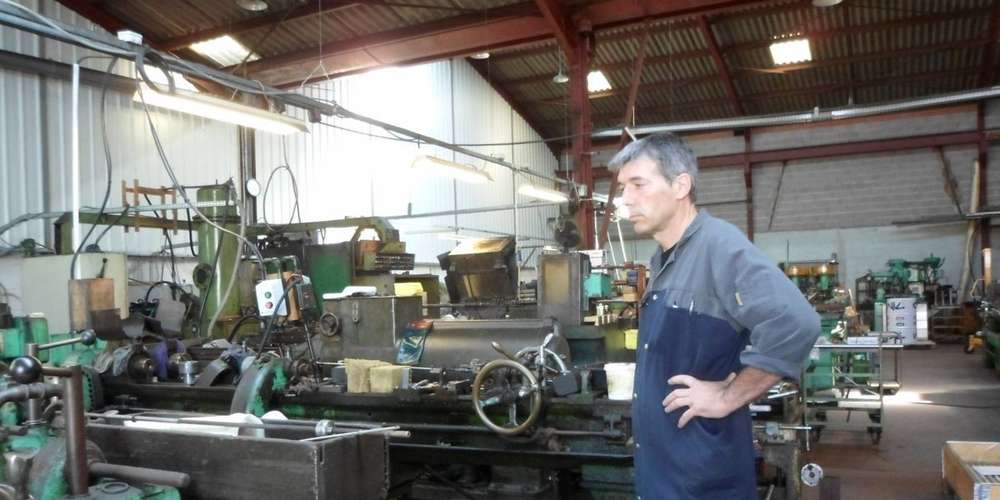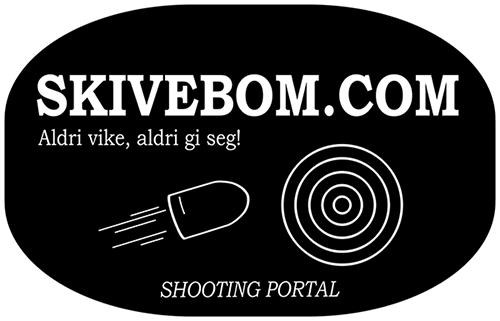
Philippe Uria fait revivre les machines de la famille dans ses ateliers aux Joncaux © Crédit photo : Edith Anselme
This is a copy an article from 2014 from sudouest.fr and hendaye-jac2 has copy it on his page in French.
The text in english is from Google translate:
Hendaye: the spirit of arms still hangs in the workshops
Posted on 07/10/2014 by Edith Anselme
The old machines of the arms factory tell of a brilliant time.
Hendaye: the spirit of arms still hangs in the workshops Philippe Uria revives the family’s machines in his workshops in Joncaux
The smell of iron and grease has a scent of nostalgia for the many Hendayans who have smelled it for years. The history of the Manufacture d’Armes des Pyrénées Françaises (MAPF) is part of the city of Hendaye.
It is also the story of a family. From 1923 to 2001, the manufacture knew how to manufacture high-quality weapons, gain the interest of the largest French administrations and achieve Olympic glory. Today, a residence stands in place of workshops with a flat roof. But Philippe Uria, one of the descendants of the founder, still works with the same precision of guns and equipment intended for aeronautics and medical. In his workshops in Joncaux, he tells the story of his family.
The tradition of arms
Between 1915 and 1917, during the First World War, the French government became interested in Basque armories, faced with the dramatic exhaustion of its reserves of automatic pistols. Weapons are ordered from Eibar, an armory town in the Spanish Basque Country. A dozen workers worked there and among them, José Vincent Uria who married the leader’s daughter.
In the aftermath of the war, the Uria family moved to Béhobie. Then José joined forces with the Arenas brothers in 1923, also from Eibar. The company moved to Hendaye in 1938 in the premises of the old cinema, at the corner of rue des Allées and specialized in the production of portable weapons. The quality, reliability and precision will make the reputation of the house.
The production of 6.35 and 7.65 Browning pocket pistols gave the company a lightning start. The 1920s were marked by an increase in crime and this 6.35 mm pistol was mass produced. Its low price, its small footprint, its ease of use and above all its freedom of acquisition and ownership are attractive. But, in 1939, it was classified in the 4th category. During the war, the armory was quickly controlled by the occupier. Then, the factory must find a new niche. It will not be that of weapons of war, the reserved domain of the factories of Saint-Etienne, but that of sport shooting and the police.
After the war, sport
The first French automatic rifle in 22 Long rifle caliber is marketed under the Unique brand. It arouses the enthusiasm of all sports shooters. For the police, the Henday workshops create the automatic pistol caliber 7.65 mm browning 9 shots. But the handgun market collapsed with the decree of June 13, 1956, in the midst of the Algerian war, which classified all pistols with annular percussion in the 4th category.
An almost fatal blow for MAPF if the two brothers Antoine and José Uria had not given it a boost by devoting themselves, in the late 60s, to competitive shooting. The DES 69 in 22 Long Rifle pistol will be the first in a long line that will bring the company to the world success of champions with Jean-Pierre Amat at the Olympic Games. But production is too elitist, fierce international competition, the coup de grace was given on February 15, 2001, with the liquidation of the company.
Today, Philippe Uria continues the family tradition, gently caressing his loyal and solid casters with his hand.
Original in french:
Hendaye : l’esprit des armes plane encore dans les ateliers
Publié le 10/07/2014 par Edith Anselme
Les anciennes machines de la manufacture d’armes racontent une époque brillante.
Hendaye : l’esprit des armes plane encore dans les ateliers Philippe Uria fait revivre les machines de la famille dans ses ateliers aux Joncaux
L’odeur de fer et de graisse a un parfum de nostalgie pour les nombreux Hendayais qui l’ont humée pendant des années. L’histoire de la Manufacture d’Armes des Pyrénées Françaises (MAPF) fait partie de la ville d’Hendaye.
C’est aussi l’histoire d’une famille. De 1923 à 2001, la manufacture a su fabriquer des armes de grande qualité, remporter l’intérêt des plus grandes administrations françaises et accéder à la gloire olympique. Aujourd’hui, une résidence s’élève à la place des ateliers au toit plat. Mais Philippe Uria, un des descendants du fondateur, travaille encore avec la même précision des canons et du matériel destiné à l’aéronautique et au médical. Dans ses ateliers des Joncaux, il raconte la saga de sa famille.
La tradition des armes
Entre 1915 et 1917, pendant la Première Guerre mondiale, le gouvernement français s’intéresse aux armureries basques, face à l’épuisement dramatique de ses réserves en pistolets automatiques. Des armes sont commandées à Eibar, cité armurière du Pays basque espagnol. Une dizaine d’ouvriers y travaillaient et parmi eux, José Vincent Uria qui épousa la fille du dirigeant.
Au lendemain de la guerre, la famille Uria s’installe à Béhobie. Puis José s’associe en 1923 aux frères Arenas, originaires eux aussi d’Eibar. La société se déplace en 1938 à Hendaye dans les locaux de l’ancien cinéma, à l’angle de la rue des Allées et se spécialise dans la production d’armes portatives. La qualité, la fiabilité et la précision feront la renommée de la maison.
La fabrication de pistolets de poche 6,35 et 7,65 Browning donne un démarrage foudroyant à l’entreprise. Les années 20 sont marquées par une recrudescence de la criminalité et ce pistolet 6,35 mm est produit en grande série. Son prix bas, son encombrement faible, sa simplicité d’utilisation et surtout sa liberté d’acquisition et de détention séduisent. Mais, en 1939, il est classé en 4è catégorie. Pendant la guerre, l’armurerie est très vite contrôlée par l’occupant. Ensuite, il faut que la manufacture trouve un nouveau créneau. Ce ne sera pas celui des armes de guerre, domaine réservé des manufactures de Saint-étienne, mais celui du tir sportif et de la police.
Après la guerre, le sport
La première carabine automatique française en calibre 22 Long rifle est mise sur le marché sous la marque Unique. Elle suscite l’engouement de tous les tireurs sportifs. Pour la police, les ateliers hendayais créent le pistolet automatique calibre 7,65 mm browning 9 coups. Mais le marché de l’arme de poing s’effondre avec le décret du 13 juin 1956, en pleine guerre d’Algérie, qui classe tous les pistolets à percussion annulaire en 4ècatégorie.
Un coup presque fatal pour la MAPF si les deux frères Antoine et José Uria ne lui avaient pas redonné une impulsion en se consacrant, à la fin des années 60, au tir de compétition. Le pistolet DES 69 en 22 Long Rifle sera le premier d’une longue lignée qui portera l’entreprise au succès mondial des champions avec Jean-Pierre Amat aux Jeux Olympiques. Mais la production est trop élitiste, la concurrence internationale farouche, le coup de grâce est donné le 15 février 2001, avec la mise en liquidation de l’entreprise.
Aujourd’hui, Philippe Uria perpétue la tradition familiale, caressant doucement de la main ses fidèles et solides machines de fonte.

I’d like more info on buying and selling these types of guns. What’s the value of these if they’re from WW2?